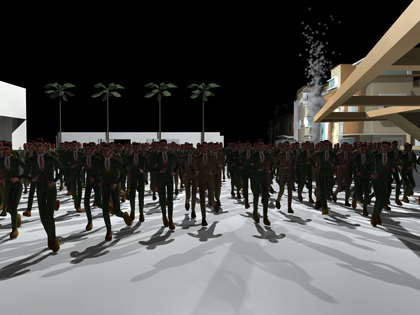
Regular readers will know that we do love a good old-fashioned urban panic here at Global Dashboard. So imagine the delight here when Bruce Schneier noted yesterday that Paul Torrens of the Arizona State University School of Geographical Sciences has devised a new computer simulation that models urban panic. Torrens’ own website has some very cool animated simulations of crowd behaviour, plus urban growth and sprawl too.![]()
![]()
![]()
Torrens explains that “the goal of this project is to develop a reusable and behaviorally founded computer model of pedestrian movement and crowd behavior amid dense urban environments, to serve as a test-bed for experimentation. The idea is to use the model to test hypotheses, real-world plans and strategies that are not very easy, or are impossible to test in practice.” Schneier cites some examples which already have us drooling with envy and anticipation:
1) simulate how a crowd flees from a burning car toward a single evacuation point;
2) test out how a pathogen might be transmitted through a mobile pedestrian over a short period of time;
3) see how the existing urban grid facilitate or does not facilitate mass evacuation prior to a hurricane landfall or in the event of dirty bomb detonation;
4) design a mall which can compel customers to shop to the point of bankruptcy, to walk obliviously for miles and miles and miles, endlessly to the point of physical exhaustion and even death;
5) identify, if possible, the tell-tale signs of a peaceful crowd about to metamorphosize into a hellish mob;
6) determine how various urban typologies, such as plazas, parks, major arterial streets and banlieues, can be reconfigured in situ into a neutralizing force when crowds do become riotous; and
7) conversely, figure out how one could, through spatial manipulation, inflame a crowd, even a very small one, to set in motion a series of events that culminates into a full scale Revolution or just your average everyday Southeast Asian coup d’état — regime change through landscape architecture.
Or as Pruned puts it more colourfully, you could decide to
… quadruple the population of Chicago. How about 200 million? And into its historic Emerald Necklace system of parks, you drop an al-Qaeda sleeper cell, a pedophile, an Ebola patient, an illegal migrant worker, a swarm of zombies, and Paris Hilton. Then grab a cold one, sit back and watch the landscape descend into chaos. It’ll be better than any megablockbuster movie you’ll see this summer.




